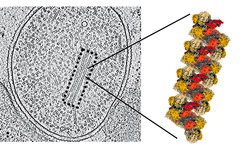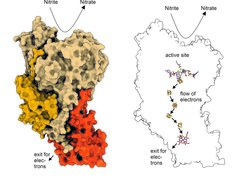Enzyme Structure Supports Microbial Growth
Researchers find a tower-like structure of a bacterial enzyme in the global nitrogen cycle
Scientists at the Max Planck Institutes for Medical Research in Heidelberg, for Marine Microbiology in Bremen and for Biophysics in Frankfurt am Main, as well as the Radboud University in Nijmegen and other partners, have successfully determined the structure of the enzyme that produces a large part of the nitrate on earth. This enzyme, nitrite oxidoreductase, is used by microorganisms to convert toxic nitrite into nitrate. Both nitrite and nitrate are nitrogen salts that have a major impact on us and our environment.

Nitrate - known, for example, as plant fertilizer - is a nutrient for many biological processes such as plant growth. Nitrate salts occur on earth in large quantities (approximately 600 billion tons). Nearly all of the nitrate found in nature is produced by the oxidation of nitrite by nitrite oxidoreductase, called NXR. NXR is thus an extremely important enzyme in the global biogeochemical nitrogen cycle. It occurs firstly in nitrite-oxidizing bacteria (NOB, including comammox organisms), which produce most of the nitrate in the environment, and secondly in anaerobic ammonium-oxidizing so-called anammox bacteria. Anammox bacteria produce about half of the elemental nitrogen in our atmosphere. The scientists involved have now been able to elucidate the structure of the enzyme NXR from anammox bacteria.
The results show in detail how NXR is structured: the individual NXR units are stacked like bones of the spinal column on top of each other, an arrangement resembling a skyscraper that has not been observed before.
"Cryo-electron tomography and helical reconstruction have shown that NXR forms these unusual tubular structures, just like long fibers, in the anammox cells," says Kristian Parey from the Max Planck Institute of Biophysics. The function of these fiber-like strands is currently unclear.
The structure of the individual single NXR molecules is clearer: on one side there is a so-called "active pocket" in which nitrite is bound and oxidized to nitrate. The released electrons are transported as a kind of an electrical pulse to the other side of the molecule. There, these electrons can be picked up by other molecules and used for cell metabolism. "Because of its importance for the global nitrogen cycle, NXR has been studied for decades, but we didn't know exactly what NXR molecules looked like," says Thomas Barends, group leader at the Max Planck Institute for Medical Research. "Now we know the detailed structure of this protein complex, which helps to understand how NXR works."
Important Discovery

"In the case of anammox bacteria, the connection between nitrite oxidation and nitrite reduction was previously a mystery," adds Boran Kartal, group leader at the Max Planck Institute for Marine Microbiology. "This study takes us a big step further in understanding how these microorganisms combine energy production and growth." The anammox process is a particularly exciting part of the nitrogen cycle: Through this process, nitrite or nitrogen oxides and ammonium are converted directly into molecular nitrogen, which, after all, makes up 78 percent of our atmosphere. "Our detailed investigation of the molecular mechanism of nitrite oxidation will help us uncover the factors that control nitrate production in nature, which is an important step in the ecological nutrient cycle," continues Kartal. Thomas Barends emphasizes, "Due to the large environmental impact of nitrite and nitrate, it is important to know how bacteria handle these substances in order to learn from their processes."
Because of their properties, anammox bacteria are increasingly used to purify wastewater in sewage treatment plants. Increasing our understanding of how they function could lead to more efficient use in the future.













